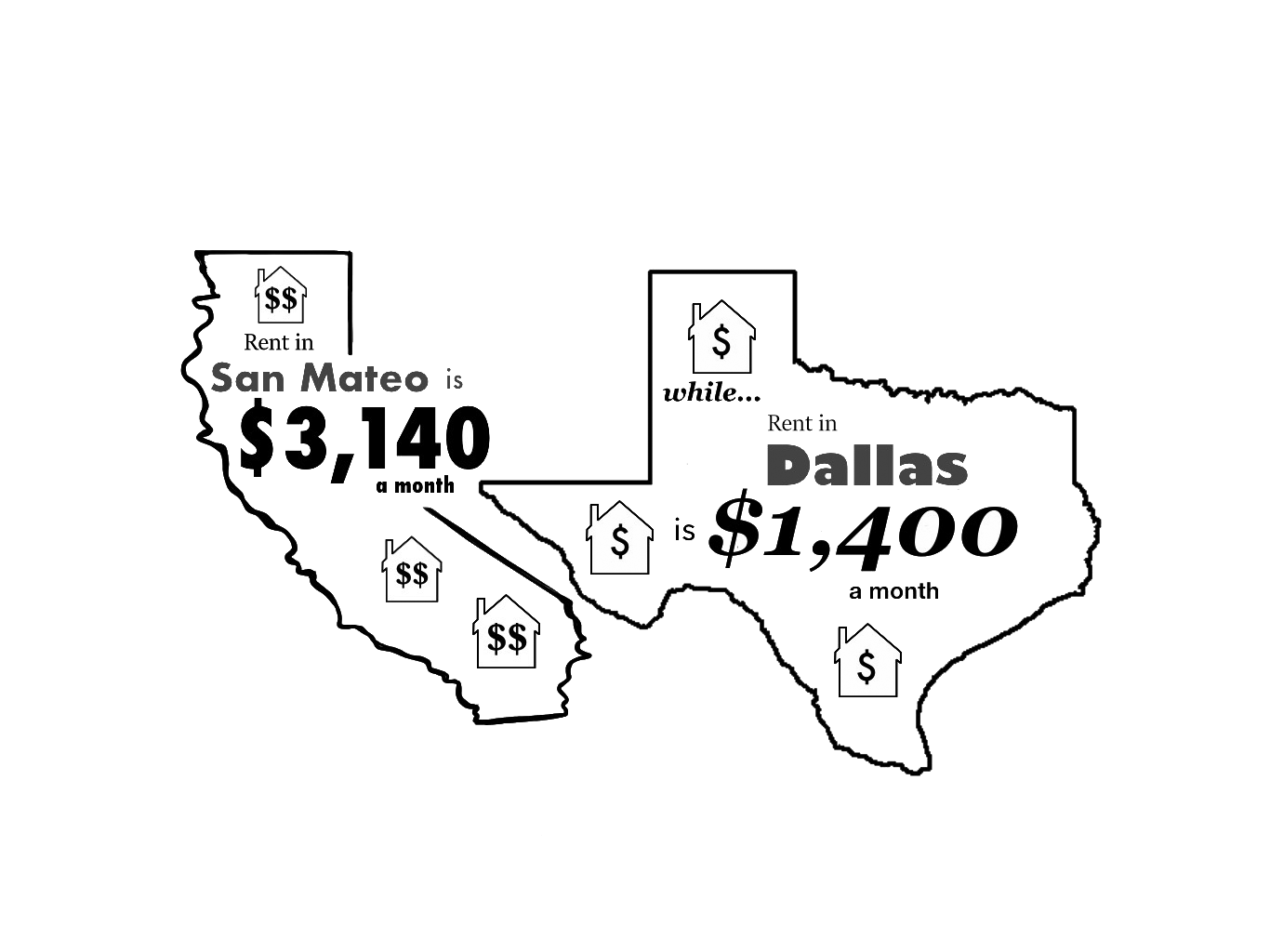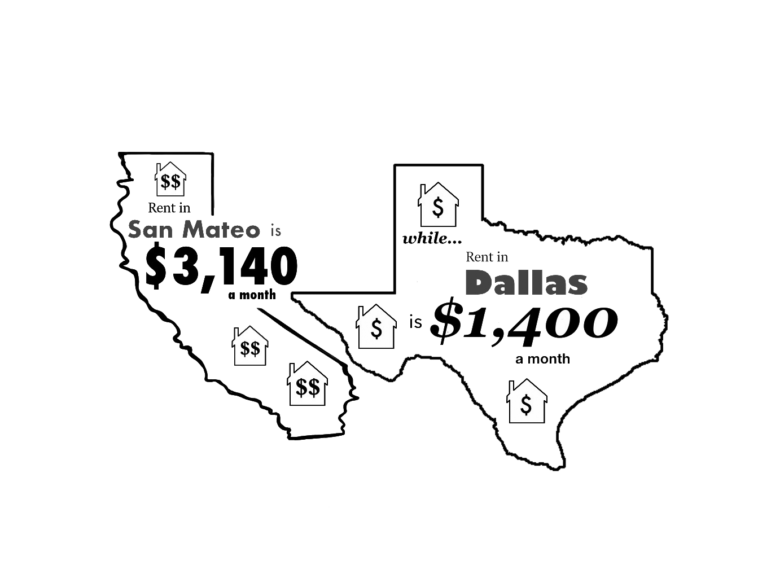
As tech companies in Silicon Valley such as Apple, Facebook and Tesla fuel the economic engine of the Bay Area, the cost of housing in the Bay Area rises even faster. Meanwhile, members of the Aragon community have been impacted in several ways.
HOUSING COSTS
A steep increase of housing prices over the last few years have caused many Bay Area residents to look elsewhere for places to live. San Mateo in specific has the highest rates of all major Bay Area cities, according to Apartment List Inc. A two-bedroom apartment in San Mateo, which costs $3,140 each month, tops the national median of $1,090 per month. Other major U.S. cities, such as Seattle and Dallas, reach a monthly fee of around $1,700 and $1,400, respectively.
“I rent a small apartment with two other people and it belongs to a very nice family member,” said social science teacher Leslie Yeung, who lives in San Francisco. “I kind of got lucky because I have a family discount.”
Yeung shares that teachers who live in San Francisco may not afford to pay the rent.
“If your apartment rent is asking five, six or seven thousand,” she said, “and that is more than you make in a month, you are being priced out.
Yeung talks about her experience as a teacher in the Bay Area.
“It is incredibly rewarding,” she said, “but thank-you cards don’t pay for your rent, they don’t put gas in your car, it doesn’t put food on your table.”
Nick Delis, a realtor in Burlingame, has realized a trend through some of his clients in the Bay Area.
“What my firsthand experience with buyers has revealed of late is that more and more residents don’t foresee staying in the area forever,” he said. “These buyers are looking for housing locations with historically stable return on investment to minimize their risk should they decide to relocate during a less robust housing market.”
Some of Delis’s clients have also relocated out of the area.
“I know that the cost of living and disposable income is a driving problem,” Delis said.

LIVING COSTS
According to Paysa, the average homeowner expense, which includes housing, food, utilities and transportation, for a family with two kids in San Mateo is $2,700 higher than the national average. The cost of living in San Mateo is higher than other top tech company cities. San Francisco is the fourth-most expensive city in the nation to live in, according to CBS Money Watch.
As a result, several staff at Aragon have chosen to live outside of the peninsula, but this comes with longer commutes to and from school.
“I live in East Oakland. I live 25 miles away,” said math and Computer Science teacher Lisa Kossiver. “I leave my house no later than 6:35 a.m. … It takes me anywhere between an hour and an hour and a half to get to work in the morning.”
However, to Kossiver, teaching at a school closer to home would not be worth it.
“I have looked for jobs [outside of the Bay Area], but that would be a $50,000 pay cut because I am top of the salary schedule here,” she said. “[Staff at Aragon] are on a salary schedule and if you switch school districts you lose all of your seniority … I will deal with the stress [of commuting].”
Kossiver notes the difference of housing prices in East Oakland and San Francisco, but is comfortable where she resides in Oakland.
“I have a very lovely home to be honest … Even though we own property in San Francisco, it is a lot smaller … [My partner and I] needed a four bedroom house and we couldn’t afford that in San Francisco. I mean, it would’ve been five times [the price].”
Kossiver, who visits her family in the Midwest often, notices that housing is much cheaper in comparison to the Bay Area.
“When we go to Cleveland we say, ‘Oh, we could have that mansion,’” she said. “But that is in the Midwest and we are a biracial couple — would that be equally as accepting?”
NEW TAX PLAN
On Nov. 16, GOP House Speaker Paul Ryan won the majority vote for the passing of a version of the tax bill. The Republican tax bill now limits the mortgage interest deduction on newly purchased homes.
“Mortgage deduction is a break on taxes that add into home affordability,” said the 2018 President of the San Mateo County Association of Realtors, Eric Berggren.
The deduction will have a greater impact in pricey cities, such as San Francisco, New York and Boston. In the past, homeowners could deduct interest on mortgages of up to $1 million, but now the cap will be reduced to $500,000. As a result, homebuyers will now face particular difficulties in affording homes.
“For most of the country, [the tax plan] doesn’t really make a difference about the amount when home prices are much lower,” Berggren said. “[In] most areas of the country, homes are between $100,000 and $500,000.”
However, Berggren does not think that the plan will have a large immediate impact in the Bay Area.
“I do not believe that it will have a great effect on our local market,” he said. “It will, however, keep some from being able to purchase here on the Peninsula. There will always be buyers. With the low inventory, I believe that the mortgage deduction will not be a big factor. If we see a shift in the market and a glut of inventory, the answer may be different.”
The bill aims to boost the U.S. economy. In theory, the new tax code will deter buyers from overbidding for a home, and therefore bring the price of houses down over time. Although this may be true, this does not take away the increasing number of employees and families moving to the Bay Area as a result of emerging tech companies.
“With the tech industry and biotech booming over the past 20 years,” Berggren said, “the Peninsula has become a very popular place to live.”
The SAMCAR, along with the California Association of Realtors and National Association of Realtors, opposes the mortgage deduction changes connected to the Republican tax bill.
“[The associations] oppose any taxes that will hurt or hinder the real estate market,” Berggren said. “Even with a small change in tax base, there will be fall out.”
The future of the Bay Area lies in more housing development.
“The commute on 101 is terrible and will only get worse over the next few years,” Berggren said. “We are seeing more homes being built along El Camino and close to train stations. This is and will continue.”



